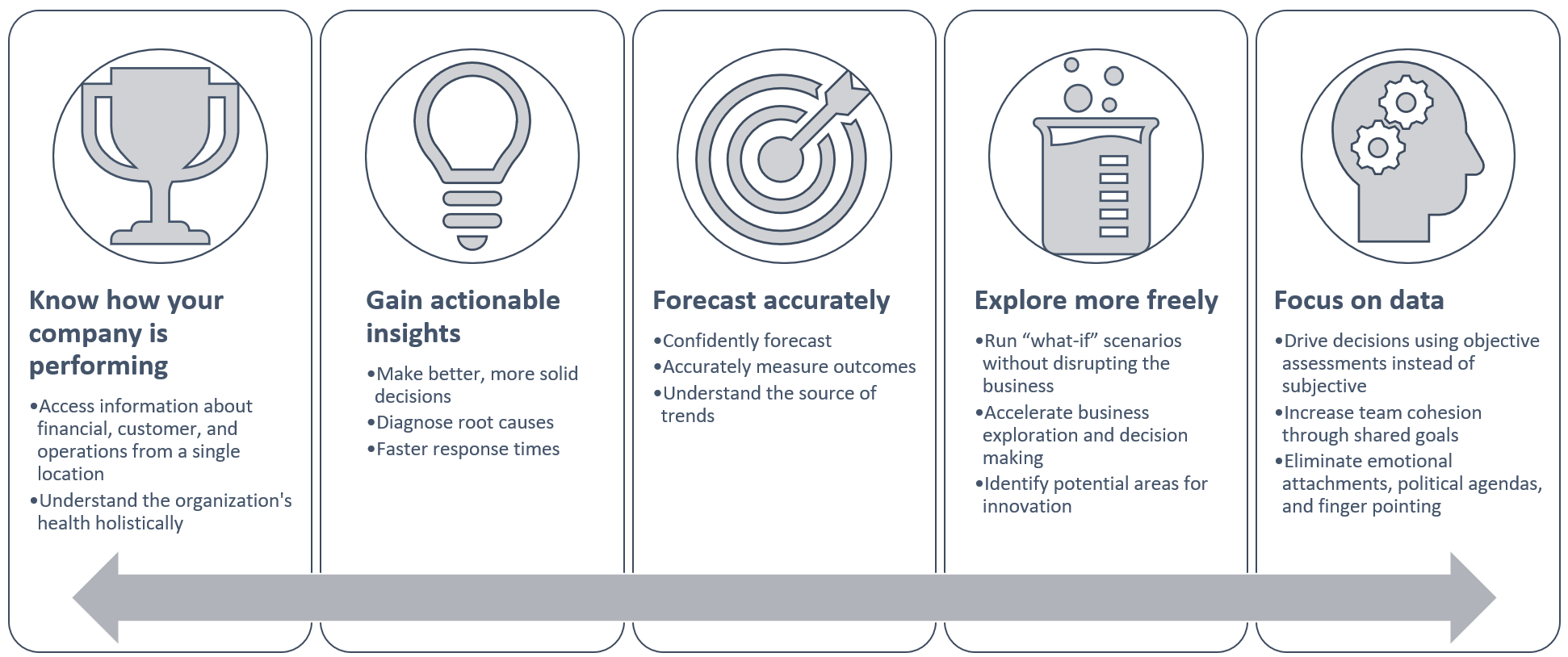Through data-driven decision making, businesses are able to gain a deeper insight into the performance of their initiatives allowing them to unlock the full potential of their organization.
Do you feel comfortable making business critical decisions?
Are you able to implement changes quickly based on historical data and performance?
Companies that use a data-driven approach make informed decisions based on trends. By focusing on the data rather than emotions, leaders create strategies rooted in evidence.
What Exactly Is Data-Driven Decision Making?

Business intelligence and data analytics are the opposite of instinct and intuition
Decisions are typically made with several subject matter experts gathering together to identify and solve issues pulling information from across the organization to make the best-informed guess. Data-driven decision making process aims to remove the biases, reduce the risk of acting on false narratives, and allow the organization to find resolution through hard facts, data and factual information.
Every data-driven decision-making process requires setting up Key Performance Indicators (KPIs) and other benchmarks to follow. KPIs are quantifiable measures of performance that help businesses to track their progress and see how close they are to achieving business goals. There are dozens of KPIs and value metrics of whose purpose is to measure the performance of systems and their business impact.
If you are using data to make decisions, then you are already a data-driven organization and will benefit from utilizing this practice.
Understanding Your Data
One example of this comes from a financial services firm that although they were experiencing success with a consistent stream of new clients, they identified challenges they weren’t able to resolve on their own.
During the client breakdown process we were able to decipher between the revenue from the most profitable clients and the costs associated with that relationship.
The Team placed a huge emphasis on customer satisfaction that over time resulted in the team being stretched too thin and struggling to find appropriate methods to address their ongoing barriers. The inability to centralize data, combined with missing, incomplete, and inaccurate data was the driving force behind the slow discovery of the root issue. The team was in need of a centralized place to view customer details that would allow for a more informed decision-making process.
The implementation of new systems resulted in immediate savings of 20x return per year, the ability to pull from a stronger pool of potential clientele, and visibility to make those data-information decisions. This has allowed the team to achieve a better work life balance while improving the service they offer.
What Is the Business Impact?
The power of data transparency is clear when executives and workstream leaders can access information and allow them to make informed decisions. Accurate, actionable data will result in more leads turning into sales, targeted products, faster response times, and an irrefutable advantage over your competitors.
Data-driven organizations will enjoy the following results:

What Would the Journey Look Like?
Bob is a CEO. He has company data spread throughout his CRM, Accounting, ERP, and HR systems. Bob’s team are experts in their respective areas, but the data is siloed and while each department has their own KPIs, it is hard to guage how the company is doing overall. In addition, while the company has been doing well financially for years, Bob has a sense that there might be more efficient ways of doing things.
Month 1
Bob begins the journey by identifying mission-critical metrics and KPIs. He works with each of his department leads to come up with 2 or 3 measures and they agree on the definition of each, where and how they can get the information and how often it makes sense to measure (weekly, monthly, quarterly).
After discussing a process and designing a schedule for reviewing data, the team agreed to use an established platform in order to store and visualize their information. They also finalized plans for using company data to make informed decisions moving forward.
Months 2-4
Now that Bob has a process in place, he determines the Sales pipeline and effectiveness are a good place to start implementing this process. Since the team already knows how to source the key metrics, they start off by identifying some leading and lagging indicators.
As they capture and report on the data, the team now has an understanding of their current Sales health. As historical data flows in, trends start to emerge, and they begin to see the impacts in the business over time.
Bob is amazed at how much he has learned about his business in just a short amount of time and tasks the Sales team with creating a plan for a deeper analysis and identifying another set of metrics.
The following months
With the success of the Sales team’s metrics, Bob tasks his other departments to start doing similar analysis. The teams, learning from the Sales department trials and errors, identify key indicators and measures, and capture from their systems so the data can be made visible.
The team now has a number of dashboards that are referenced in meetings and emails. Bob notices the meetings are shorter, more productive, and there is a lot less finger-pointing.
Making informed decisions is an outcome of drawing conclusions from the insights gathered from the company’s data. Armed with information, Bob decides to pull the trigger on an opportunity that has been in the backlog for a while and is now supported by past performance.
The following years
They are reaching their target audience, investing in the right areas and headcount is increasing but productivity is through the roof. People are focusing on handling edge cases and exceptions, not the day-to-day report creation, data wrangling, or manual processing. Company morale is high, because people are doing high-value work and not fighting with each other.
Bob is considering going all in and looking into Artificial Intelligence (AI) to help further analyze historical trends to optimize the decision process and make better predictions.
How Do I Get Started?

When you are ready to make the transition to a data-driven organization, consider the following:
1) Collaboration and commitment from the executive level .
2) Brainstorming sessions to capture, process, and review your organization’s data .
3) An execution plan that considers your organizations unique challenges and company needs to perform at its highest potential.
4) Finding the right partner that is able to share your vision for the company to help execute the process.









